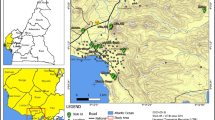Abstract
As is well known, in order to select remediation measures to correct or prevent slope instabilities, it is essential to identify and characterize the instability mechanisms. This task is especially complex for heterogeneous rock masses such as Flysch formations. This paper addresses the assessment of corrective measures used in carbonate Flysch formations by classifying and grouping field data reported in an available database in order to associate this data with various instability mechanisms and stratigraphic column types as well as with the corrective measures taken to stabilise them. For this purpose, 194 slopes have been geomechanically characterized, mainly by considering the observed instability mechanisms. The corrective measures that were applied have been evaluated for their suitability and performance, and, if applicable, the causes of their malfunction have been also studied. As a result, some guidelines based on the observed behaviour and the suitability of the correction measure as a function of instability type are proposed for similar slopes.
Résumé
Comme il est bien connu, dans le but de sélectionner les mesures correctives pour corriger ou prévenir des instabilités de pente, il est essentiel d’identifier et de caractériser les mécanismes d’instabilité. Cette tâche est d’autant plus complexe pour les masses rocheuses hétérogènes telles que des formations de Flysch. Cet article traite de l’évaluation des mesures correctives utilisées dans les formations du Flysch carbonatée, en classant et groupement des données de terrain figurant dans une base de données disponible, afin d’associer ces données avec les différents mécanismes d’instabilité et les colonnes stratigraphiques type, ainsi que des mesures correctrices prises pour les stabiliser. A cet effet, 194 pentes ont été geomécaniquement caractérisées, principalement en examinant les mécanismes d’instabilité observées. Les mesures correctives qui ont été mis en œuvre ont été évaluées pour leur pertinence, la performance et, le cas échéant, les causes de leur dysfonctionnement. En conséquence, certaines lignes directrices fondées sur le comportement observé et l’adéquation de la mesure de correction en fonction du type de l’instabilité sont proposées pour des pentes similaires.





Similar content being viewed by others
References
Andrew RD, Bartingale R, Hume H (2011) Context sensitive rock slope design solutions. U.S. Department of Transportation, Federal Highway Administration (FHWA), Central Federal Lands Highway Division, Publication No. FHWA-CFL/TD-11-002
Arbanas Ž, Grošić M, Jurić-Kaćunić D (2007) Experiences on flysch rock mass reinforcing in engineered slopes. In: 11th Cogress of the International Society for Rock Mechanics-Ribeiro e Sousa, Olalla & Grossmann (ed). Taylor & Francis Group, London 597–600
Arbanas Ž, Grošić M, Briški G (2008) Behaviour of Engineered Slopes in Flysch Rock Mass. Proceedings of the 1st Southern Hemisphere International Rock Mechanics Symposium, Perth, Australia, Australian Centre for Geomechanics 493–504
Baynes FJ, Fookes PG, Kennedy JF (2005) The total engineering geology approach applied to railways in the Pilbara, Western of Australia. Bull Eng Geol Environ 64:67–94
Cano M, Tomás R (2013) Characterization of the instability mechanisms affecting slopes on carbonatic Flysch: Alicante (SE Spain), case study. Eng Geol 156:68–91
Colodrón I, Ruiz V (1980) Mapa Geológico de Villajoyosa escala 1:50.000 (No. 847), IGME
Fookes PG, Sweeney M (1976) Stabilization and control of local rockfalls and degrading rock slopes. Quart J Eng Geol 9:37–55
Hoek E, Bray J (1981) Rock slope engineering, 3rd edn. Institute of Mining and Metallurgy, London
Hutchinson JN (1977) Assessment of the effectiveness of corrective measures in relation to geological conditions and types of slope movement. Bull Int Assoc Eng Geol 16:131–155
IGN, Instituto Geográfico Nacional (2012) Página web: www.ign.es
Kengel KJ (1978) Types of rockslopes_Possibilities of classification and rerivation of correctives measures. Bull Int Assoc Eng Geol 17:52–55
Leret-Verdú G, Núñez-Galiano A, Colodrón-Gómez I, Martínez del Olmo W (1976) Mapa Geológico de Alicante escala 1:50.000 (N 872) IGME
Pierson LA, Davis SA, Van Vickle R (1990) Rockfall hazard rating system implementation manual. Federal Highway Administration (FHWA). Report FHWA-OR—EG-90-01. FHWA, U.S. Department of Transportation
Popescu M (2001) A suggested method for reporting landslide remedial measures. Bull Eng Geol Environ 60:69–74
Roep TB, Everts AJ (1992) Pillow-beds: A new type of seismites? An example from an Oligocene turbidite fan complex, Alicante, Spain. Sedimentology 39:711–724
Šestanović S, Štambuk N, Samardžija I (1994) Control of the stability and protection of cut slopes in Flysch. Geol Croat 47(1):139–148
Uribe-Etxebarria G, Morales T, Uriarte JA, Ibarra V (2005) Rock cut stability assessment mountainous regions. Environ Geol 48:1002–1013
Wyllie DC, Mah CW (2004) Rock slope engineering, civil and mining, 4th ed., Spon Press, Taylor & Francis Group, New York, p 431
Acknowledgments
The authors would like to thank the anonymous reviewers for their valuable comments and suggestions to improve the quality of the paper. This work was partially funded by the University of Alicante under the vigrob-157, uausti11–11, and gre09–40 projects and by the Generalitat Valenciana under Project gv/2011/044.
Author information
Authors and Affiliations
Corresponding author
Rights and permissions
About this article
Cite this article
Cano, M., Tomás, R. Assessment of corrective measures for alleviating slope instabilities in carbonatic Flysch formations: Alicante (SE of Spain) case study. Bull Eng Geol Environ 72, 509–522 (2013). https://doi.org/10.1007/s10064-013-0514-3
Received:
Accepted:
Published:
Issue Date:
DOI: https://doi.org/10.1007/s10064-013-0514-3




